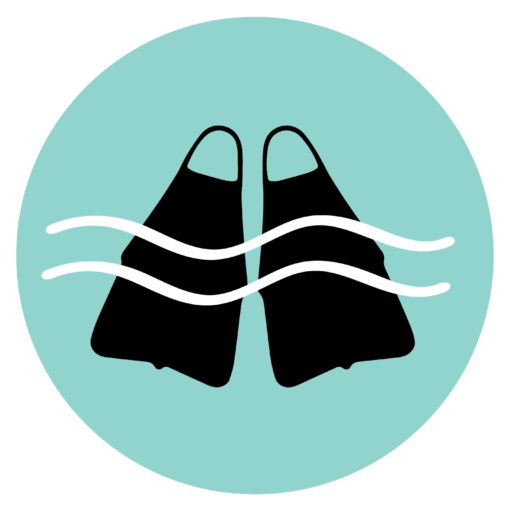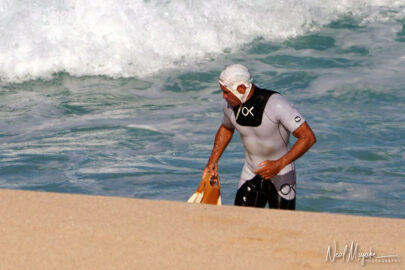We all know Kelly Slater is the best surfer in the world, but did you know he’s a really good bodysurfer too? That’s right! The eleven-time world champion has been bodysurfing his entire professional surfing career.
In fact, Slater is featured in Jack Johnson’s 2004 film, A Brokedown Melody, bodysurfing the Banzai Pipeline with Mark Cunningham. (Slater can be seen bodysurfing at 8:11 and 48:08).
“A lot of times it will be super crowded and there won’t be many waves,” says Slater, referring to Pipeline. “The beginning of a swell can be really inconsistent so I might go bodysurfing, and inevitably Mark is gonna be out there.”
Mark Cunningham served 29 years as a lifeguard on Oahu’s north shore and was one of the first bodysurfers to take Slater under his wing at the Banzai Pipeline.
“You don’t take anything for granted and you ride the wave as far as you can,” says Slater about bodysurfing Pipeline. “You don’t kick out when the barrel stops and you realize how much room there is out there even with all the people.”
Slater competes at the Pipeline Bodysurfing Classic
Slater has competed in the Pipeline Bodysurfing Classic—the premiere bodysurfing contest in the world—on multiple occasions. He even finished top ten in the 2020 competition.
One of Slater’s first competitive bodysurfing appearances was in 2002, when he entered the Pipeline Bodysurfing Classic alongside professional surfers Tom Curren and Rob Machado.

Slater, who had already won six world surfing championships by ’02, made it all the way to the semi-finals. This was no small feat considering the high level of competition that year. Mike Stewart and Mark Cunningham—two of the world’s best bodysurfers at the time—both made it to the finals.
Did bodysurfing help Slater’s board-surfing?
For centuries, anyone who board-surfed—by way of necessity—also knew how to bodysurf. Prior to the invention of the surf leash in the 1970s, the two methods of wave-riding went hand in hand.
“The surf leash broke up surfing and bodysurfing,” says surf historian Matt Warshaw, “which up to that point had been forever united—wipeout, lose board, bodysurf, repeat.”
There is a great video clip of professional surfer Russell Hughes bodysurfing at the 1968 World Surfing Championships in Puerto Rico. In the pre-leash days, all professional surfers would have been world-class bodysurfers.
Tragically, the invention of the surf leash meant surfers in Kelly Slater’s generation didn’t have to learn to bodysurf in after their lost boards. Slater learned anyway, which no doubt helped his surfing tremendously.

Most professional surfers are bodysurfers
Not only does bodysurfing make us stronger swimmers and better breath-holders, but it also provides us with the necessary foundation to become better surfers.
Bodysurfing teaches us how to read waves, how to dive beneath them, and how to catch them. Bodysurfing also teaches us how to navigate the lineup, and how to identify rip currents and other potential hazards.
To be a professional surfer, especially a professional big wave surfer like Justine Dupont, bodysurfing is a necessary and potentially life-saving skill. Dupont says bodysurfing is her favorite way to train for big wave sessions.
Not surprisingly, many of the best professional surfers in the world are also great bodysurfers—Dave Rastovich, Rob Machado, Greg Long, Belinda Baggs, Tom Curren, Gerry Lopez, and the Malloy brothers.
Perhaps these professional surfers take pleasure in bodysurfing simply because there is less pressure to perform.
Pipe Dreams
In his book Pipe Dreams: A surfer’s Journey, Slater recounts how he fell in love with bodysurfing at Pipeline in 1994:
“That winter in Hawaii, every day Pipe broke, we bodysurfed. It was great training—probably the best cardiovascular workout we got—since we were moving all the time just to stay afloat. We stopped wearing leashes when we surfed so we could practice bodysurfing to our boards after a wipeout. Even when the waves are horrible, bodysurfing can still be a blast. The sensation of speed, even on a tiny wave, is incredible, much more intimate than riding a surfboard.”

For the Love
In his second book, Kelly Slater: For the Love, Slater’s bodysurfing guru Mark Cunningham speculates on what draws professionals surfers to bodysurfing:
“Another attraction in bodysurfing—and I’ve noticed this in Machado, too—is that these guys are under such a hot, burning spotlight the minute they set foot on a beach. They walk down there with a board under their arm and every eye is on them. I can’t imagine that pressure. The beauty of bodysurfing is that you’re not going to bust a mind-blowing air or get the tube of the day. If you get in the pocket for three or four seconds, that’s a bitchin’ ride. I think part of the appeal is that Kelly can go out in the water and not have to be the top dog; sort of anonymous. That’s what I enjoy about it. I’m not performing on the ocean. I’m just in it, just a piece of it, just this little coconut head floating on the surface.”
If there’s one piece of advice I have for you aspiring surfers out there, it’s to practice bodysurfing. It certainly worked for Kelly Slater.


